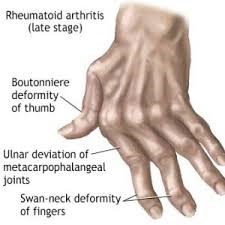Rheumatoid arthritis
A ray of hope for the cure of rheumatoid arthritis by Shreevidya Herbal Research center
Rheumatoid arthritis (RA) is an autoimmune disease where the body attacks itself, causing chronic joint inflammation. While it primarily affects joints, it can also cause inflammation of organs as the disease progresses. People with RA may experience an increase in symptoms –called flares – that can last for days or weeks. They may also have periods of remission where they have few or no symptoms. There is no cure for rheumatoid arthritis in modern system of medicine, but non steroid anti inflammatory drugs(NSAID) and steroids are given which according to some slow the progression of the disease and ease symptoms. The side effects of these drugs are sever.
Juvenile Rheumatoid Arthritis
Juvenile rheumatoid arthritis (JRA), also called juvenile idiopathic arthritis (JIA), is a type of arthritis that occurs in children age 1 to 16. Symptoms include stiff, sowllen, painful joints, and sometimes fever and rash. To be diagnosed with JRA the child’s symptoms must last at least six weeks
Difference Between Normal, Healthy Joints and Arthritic Joints
Arthritis refers to more than 100 conditions that affect the musculoskeletal system, specifically, the joints. The joints are the parts of the body where bones connect. When arthritis is present, the joints may become inflamed, stiff, red, and painful. Rheumatoid arthritis is one type of arthritis classified as ‘systemic,’ meaning it can affect the entire body. Damage from RA may occur in tissues surrounding the joints including the tendons, ligaments, and muscles. In some patients, symptoms may extend to the skin and eyes, and internal organs including the liver, kidneys, heart, and lungs



Rheumatoid Arthritis Causes
The exact cause of rheumatoid arthritis remains unknown in modern system, but several risk factors have been identified. Estrogen in women, genetic components, cigarette smoking, Occupational exposure to certain dusts such as silica, wood, or asbestos are the few suspected causes of rheumatoid arthritis.
Remission, Relapse, and Flares in rheumatoid arthritis
When a person with rheumatoid arthritis has symptoms including joint inflammation and pain, this is called a flare. Flares may last from weeks to months. This can alternate with periods of remission, when symptoms are minimal to nonexistent. Periods of remission can last weeks, months, or even years. After a period of remission, if the symptoms return this is called a relapse. It is common for RA patients to have periods of flares, remissions, and relapses, and the course of the illness varies with each patient.
Rheumatoid Arthritis Symptoms
Rheumatoid arthritis symptom are
- swollen, painful, and stiff joints and muscles
- fatigue
- low-grade fever
- lack of energy
- loss of appetite
The muscle and joint stiffness is usually worst in the morning or after extended periods of inactivity.
Other rheumatoid arthritis symptoms include bumps under the skin (rheumatoid nodules), shortness of breath due to inflammation or damage to the lungs, hoarseness, and eye problems.
With rheumatoid arthritis, hands are almost always affected. However, RA can affect any joint in the body, including wrists, elbows, knees, feet, hips, and even the jaw. In most cases joints are affected symmetrically, meaning the same joints on both sides of the body are affected.
Rheumatoid arthritis can be very painful, and chronic inflammation can lead to debilitating loss of cartilage, bone weakness, and joint deformity.
A ray of hope for the rheumatoid arthritis patients by Shreevidya Herbal Research center
Through intense research, the herbal scientists of SVHRC have found out herbal medicine and treatment for RA.
Autotoxination, the Cause of RA
Prolonged continual assimilation of undigested putrefying material into the bloodstream of the body due to improper digestion of food results in toxin saturation to the point where the somatic immune system fails in its functioning and the toxins get accumulated in the joints and the serum causing the damage of the joints
Case study:
The first patient of RA was Mr. V. G(name changed)
His age was 42 years in 2012. The symptoms were swelling in both his knee joints, stiffness, unable to move around and he was bed ridden. RA test was positive. It was a very early diagnosis. After diagnosis, he directly consulted the physicians of SVHRC. He did not take any steroids or painkillers. Treatment was started immediately. After 10 days of treatment, he was able to walk and move around. Treatment was continued for a month. It was found that after one month, all the signs and symptoms were disappeared. Treatment was stopped. After six months again RA was done which was negative.
TREATMENT PROTOCOL
Early diagnosed RA can be cured. If the patient has taken lots of steroids doses and NSAIDs(non steroid anti-inflammatory drugs-pain killers), it will take long time to get cured as it takes time to get rid of the bad effects of steroids and NSAIDs. As steroids reduce the bone calcium and bone mineral density, herbal supplements of bone calcium will be added to the treatment. Strict vegetarian controlled diet is advised during the treatment.
